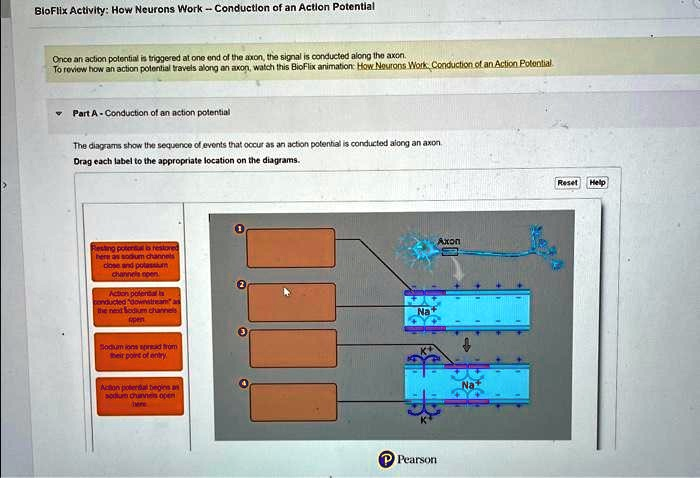How Neurons Work – Conduction of an Action Potential Once an action potential is triggered at one end of the axon, the signal is conducted along the axon. To review how an action potential travels along an axon, watch this BioFlix animation: How Neurons Work, Conduction of an Action Potential Part A – Conduction of an action potential The diagrams show the sequence of events that occur as an action potential is conducted along an axon. Drag each label to the appropriate location on the diagrams. Resting potential is restored here as sodium channels close and potassium channels open Action potential is conducted “downstream” as the next sodium channels open Sodium ions spread from their point of entry Action potential begins as sodium channels open Axon Na
Na
K
K
Reset Help

The Correct Answer and Explanation is:
Based on the process of action potential conduction along an axon, here is the correct sequence of events and how each label corresponds to a region of the axon:
- Action potential begins as sodium channels open – This occurs at the initial segment of the axon. When a stimulus reaches threshold, voltage-gated sodium channels open, and sodium ions flood into the neuron, reversing the membrane potential locally.
- Sodium ions spread from their point of entry – The influx of sodium ions creates a localized area of positive charge. These ions then diffuse within the axoplasm (the cytoplasm of the axon) toward adjacent areas, causing those segments to reach threshold as well.
- Action potential is conducted “downstream” as the next sodium channels open – The depolarization spreads sequentially along the axon as neighboring voltage-gated sodium channels open in a wave-like fashion. This is the essence of how the signal propagates.
- Resting potential is restored here as sodium channels close and potassium channels open – As the action potential passes, sodium channels inactivate, and voltage-gated potassium channels open. Potassium ions leave the cell, restoring the membrane potential to its resting state.
Explanation
The conduction of an action potential along an axon is a fundamental process in neuronal communication. It is initiated when the neuron reaches a threshold due to a stimulus, causing voltage-gated sodium channels at the axon hillock to open. Sodium ions enter rapidly, depolarizing the membrane.
This localized depolarization creates a positive charge that spreads passively along the inside of the membrane. As these sodium ions diffuse, they depolarize adjacent segments of the axon to threshold, opening the next set of sodium channels. This chain reaction is what allows the action potential to travel without diminishing in strength.
Immediately after the sodium channels open and close, potassium channels open in the same region. Potassium exits the cell, bringing the membrane potential back toward the resting state. This ensures the signal moves in one direction, as the previous segment temporarily enters a refractory period, preventing it from firing again right away.
The conduction continues in this stepwise fashion along the entire length of the axon. At each point, sodium influx triggers depolarization, followed by potassium efflux that repolarizes the membrane.
This carefully timed coordination between sodium and potassium channels ensures a rapid, efficient transmission of signals across long distances, enabling complex processes like muscle contraction, sensory perception, and thought.
